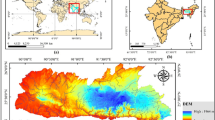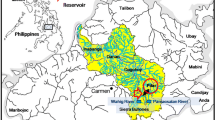Abstract
Geologically and tectonically active Himalayan Range is characterized by highly elevated mountains and deep river valleys. Because of steep mountain slopes, and dynamic geological conditions, large-scale landslides are very common in Lesser and Higher Himalayan zones of Nepal Himalaya. Slopes along the major highways of central Nepal namely Prithvi Highway, Narayangadh-Mugling Road and Tribhuvan Highway are considered in this study of large-scale landslides. Geologically, the highways in consideration pass through crushed and jointed Kathmandu Nappe affected by numerous faults and folds. The relict large-scale landslides have been contributing to debris flows and slides along the highways. Most of the slope failures are mainly bechanced in geological formations consisting phyllite, schist and gneiss. Laboratory test on the soil samples collected from the failure zones and field investigation suggested significant hydrothermal alteration in the area. The substantial hydrothermal alteration in the Lesser Himalaya during advancement of the Main Central Thrust (MCT) and thereby clay mineralization in sliding zones of large-scale landslide are the main causes of large-scale landslides in the highways of central Nepal. This research also suggests that large-scale landslides are the major cause of slope failure during monsoon in the Lesser Himalaya of Nepal. Similarly, hydrothermal alteration is also significant in failure zone of the large-scale landslides. For the sustainable road maintenance in Nepal, it is of utmost importance to study the nature of sliding zones of large-scale landslides along the highways and their role to cause debris flows and slides during monsoon period.













Similar content being viewed by others
References
Amatya KM, Jnawali BM (1994) Geological map of Nepal. Scale: 1:1,000,000. Kathmandu, Nepal
Anders MH, Wiltschko DV (1994) Microfracturing, paleostress and growth of faults. J Struct Geol 16(6):795–815
Bhattarai DR (1980) Some geothermal spring of Nepal. Tectonophysics 62:7–11
Bilham RK, Larson JF, Project Idylhim Members (1997) GPS measurements of present-day convergence across the Nepal Himalaya. Nature 386:61–64
Bishop AW, Green GE, Garga VK, Andresen A, Brown JD (1971) A new ring shear apparatus and its application to the measurement of residual strength. Geotechnique 21(4):273–328
Brunel M (1986) Ductile thrusting in the Himalayas: shear sense criteria and stretching lineations. Tectonics 5:247–265
Burbank DW, Leland J, Brozovic EN, Reid MR, Duncan C (1996) Bedrock incision, rock uplift and threshold hillslopes in the northwestern Himalayas. Nature 379(6565):505–510
Caine N, Mool PK (1982) Landslides in the Kolpu Khola drainage, Middle Mountains, Nepal. Mountain Res Dev 2:157–173
Chalise SR, Khanal NR (2001) Rainfall and related natural disasters in Nepal. In: Li Tianchi, Chalise SR, Upreti BN (eds) Landslide hazards, mitigation to the Hindukush-Himalayas. ICIMOD, Kathmandu, pp 63–70
Copeland P, Harrison TM, Hodges KV, Mareujol P, Le Fort P, Pecher A (1991) An early Pliocene thermal perturbation of the main central thrust, central Nepal: implications for Himalayan tectonics. J Geophys Res 96:8475–8500
Curewitz D, Karson JA (1997) Structural settings of hydrothermal outflow: fracture permeability maintained by fault propagation and interaction. J Volcanol Geotherm Res 79:149–168
Dahal RK (2006) Geology for technical students. Bhrikuti Academic Publication, Kathmandu, p 756
Dahal RK, Hasegawa S (2008) Representative rainfall thresholds for landslides in the Nepal Himalaya, Geomorphology, doi:10.1016/j.geomorph.2008.01.014, p 15 (in press)
Dahal RK, Hasegawa S, Masuda T, Yamanaka M (2006) Roadside slope failures in Nepal during torrential rainfall and their mitigation, In: Marui et al. (eds) Disaster mitigation of debris flow, slope failures and landslides, (Interpraevent 2007), Universal Academy Press, Tokyo, vol 2, pp 503–514
Dai F, Lee CF, Wang S, Yuyong F (1999) Stress-strain behaviour of a loosely compacted volcanic derived soil and its significance to rainfall-induced fill slope failures. Eng Geol 53(3–4):359–370
Deniel C, Vidal P, Fernandez A, Le Fort P, Peucat J-J (1987) Isotopic study of the Manaslu granite (Himalaya Nepal): inferences on the age and source of Himalayan leucogranites. Contrib Mineral Petrol 96:78–92
Embley EW, Chadwick WW (1994) Volcanic and hydrothermal processes associated with a recent phase of seafloor spreading at the northern Cleft segment: Juan de Fuca Ridge. J Geophys Res 99:4741–4760
Evans MJ, Derry LA, Anderson SP, France-Lanord C (2001) Hydrothermal source of radiogenic Sr to Himalayan rivers. Geology 29:803–806
Frattini P, Crosta GB, Fusi N, Negro PD (2004) Shallow landslides in pyroclastic soils: a distributed modelling approach for hazard assessment. Eng Geol 73:277–295
Ganser A (1964) Geology of the Himalaya. Inter Science John Wiley, London
Gerrard J (1994) The landslide hazard in the Himalayas: geological control and human action. Geomorphology 10:221–230
Gerrard J, Gardner RAM (2000) Relationships between rainfall and landsliding in the Middle hills. Nepal Norsk geogr Tidsskr 54:74–81
Hagen T (1969) Report on the geological survey of Nepal preliminary reconnaissance: Zürich, Mémoires de la soc. Helvétique des sci. naturelles, p 185
Harris N, Inger S, Massey J (1993) The role of fluids in the formation of High Himalayan Leucogranites. In: Treloar PJ, Searle MP (eds) Himalayan tectonics, geological society special publication No 74, pp 391–400
Harrison TM, Ryerson FJ, LeFort P, Yin A, Lovera O, Catlos EJ (1997) A late Miocene-Pliocene origin for the central Himalayan inverted metamorphism. Earth Planet Sci Lett 146:E1–E7
Harrison TM, Grove M, McKeegan KD, Coath CD, Lovera OM, Le Fort P (1999) Origin and episodic emplacement of the Manaslu intrusive complex, central Himalaya. J Petrol 40(1):3–19
Heuberger H, Masch L, Preuss E, Schrocker A (1984) Quaternary landslides and rock fusion in central Nepal and in the Tyrolean Alps. Mt Res Dev 4:345–362
Hodges KV, Parrish RR, Searle MP (1996) Tectonic evolution of the central Annapurna Range, Nepalese Himalaya. Tectonics 15:1264–1291
Ives JD, Messerli B (1981) Mountain hazards mapping in Nepal; introduction to an applied mountain research project. Mt Res Dev 1:223–230
Laban P (1979) Landslide occurrence in Nepal. HMG/FAO and UNDP, Ministry of Forest, Department of Soil Conservation, Integrated Watershed Management, Kathmandu, pp 27
Lachenbrunch AH (1980) Frictional heating, fluid pressure, and the resistance to fault motion. J Geophys Res 85:6097–6112
Le fort P (1988) Granite in the tectonic evolution of the Himalaya, Karakoram and Southern Tibet. Philos Trans R Soc Lond Ser 326(A):281–298
Meigs AJ, Burbank DW, Beck RA (1995) Middle–Late Miocene (>10 Ma) formation of the main boundary thrust in the western Himalaya. Geology 23(5):423–426
Schelling D (1992) The tectonostratigraphy and structure of the eastern Nepal Himalaya. Tectonics 11:925–943
Scholz CH (1980) Shear heating and the state of stress on faults. J Geophys Res 85:6174–6184
Searle MP, Parrish RR, Hodges KV, Hurford A, Ayres MW, Whitehouse MJ (1997) Shisha Pangma Leucogranite, South Tibetan Himalaya: field relations, geochemistry, age, origin, and emplacement. J Geol 105:295–318
Searle MP, Noble SR, Hurford AJ, Rex DC (1999) Age of crustal melting, emplacemet and exhumation history of the Shivling leucograpnite, Garhwal Himalaya. Geol Mag 136(5):513–525
Selby MJ (1988) Landforms and denudation of the High Himalaya of Nepal: results of continental collision. Z Geomorphol Neue Folge 69:133–152 Supplementeband
Shakoor A, Smithmyer AJ (2005) An analysis of storm-induced landslides in colluvial soils overlying mudrock sequences, southeastern Ohio, USA. Eng Geol 78:257–274
Shang Y, Yang Z, Li L, Liu D, Liao Q, Wang Y (2003) A super large landslide in Tibet in 2000: background, occurrence, disaster, and origin. Eng Geol 54:225–243
Shroder JF, Bishop MP (1998) Mass movement in the Himalaya: new insights and research directions. Geomorphology 26:13–35
Upreti BN (1999) An overview of the stratigraphy and tectonics of the Nepal Himalaya. J Asian Earth Sci 17:577–606
Upreti BN (2001) The Physiography and geology of Nepal and landslide hazards. In: Tianchi L, Chalise SR, Upreti BN (eds) Landslide problem mitigation to the Hindukush-Himalayas, ICIMOD, p 312
Upreti BN, Dhital MR (1996) Landslide studies and management in Nepal. ICIMOD, Nepal, p 87
Wagner A (1983) The principal geological factors leading to landslides in the foothills of Nepal: a statistical study of 100 landslides—steps for mapping the risk of landslides. HELVETAS–Swiss Technical Cooperation and ITECO–Company for International Cooperation and Development, unpublished, pp 58
Wohletz K, Heiken G (1992) Volcanology and geothermal energy. University California Press, CA, p 432
Yilmaz I, Karacan E (2002) A landslide occured in clayey soils: an example from Kýzýldag region of Sivas-Erzincan highway (Sivas-Turkey). AAPG Div Environ Geosci 9(1):35–42
Yilmaz I, Yildirim M (2006) Structural and geomorphological aspects of the Kat landslides (Tokat-Turkey), and susceptibility mapping by means of GIS. Environ Geol 50(4):461–472
Acknowledgments
This research was partly support by “Grant-in-Aid for Overseas Scientific Research and Investigation” of the Ministry of Education, Culture, Science and Technology, Japan. Mr. Anjan Kumar Dahal and Ms. Seiko Tsuruta are sincerely acknowledged for their technical support during the preparation of this paper.
Author information
Authors and Affiliations
Corresponding author
Rights and permissions
About this article
Cite this article
Hasegawa, S., Dahal, R.K., Yamanaka, M. et al. Causes of large-scale landslides in the Lesser Himalaya of central Nepal. Environ Geol 57, 1423–1434 (2009). https://doi.org/10.1007/s00254-008-1420-z
Received:
Accepted:
Published:
Issue Date:
DOI: https://doi.org/10.1007/s00254-008-1420-z




